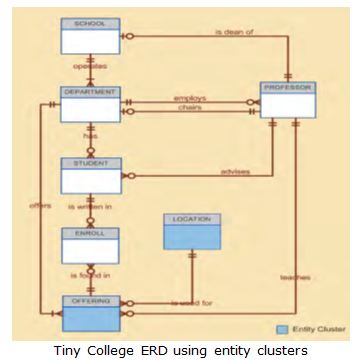Entity Clustering
An entity cluster is a “virtual” entity type used to represent multiple entities and relationships in the ERD. An entity cluster is formed by combining multiple interrelated entities into a single abstract entity object. An entity cluster is considered “virtual” or “abstract” in the sense that it is not actually an entity in the final ERD. Instead, it is a temporary entity used to represent multiple entities and relationships, with the purpose of simplifying the ERD and thus enhancing its readability.
The following Figure illustrates the use of entity clusters which contains two clusters:
• OFFERING, which groups the COURSE and CLASS entities and relationships.
• LOCATION, which groups the ROOM and BUILDING entities and relationships.
When using entity clusters, the key attributes of the combined entities are no longer available. Without the key attributes, primary key inheritance rules change. In turn, the change in the inheritance rules can have undesirable consequences, such as changes in relationships—from identifying to non-identifying or vice versa—and the loss of foreign key attributes from some entities. To eliminate those problems, the general rule is to avoid the display of attributes when entity clusters are used.
You May Also Like:
Difference between partial completeness and total completeness


